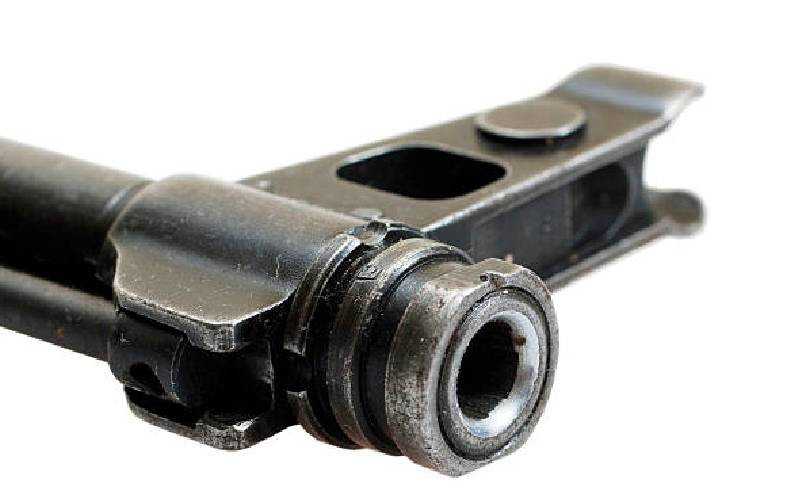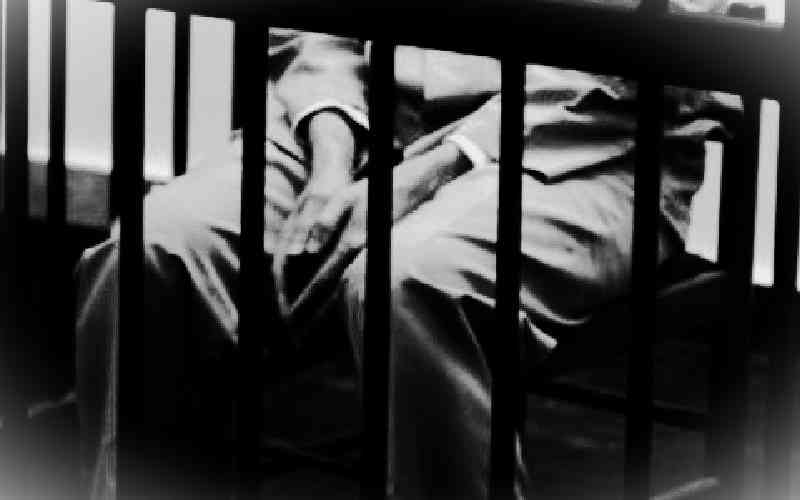A flawless escape: this is what happens when an inmate outsmarts a system and his jailers become jailbirds. Unfortunately, the inmate’s friends were collateral damage. BY JOSAYA WASONGA
To break out of a Kenyan prison, you do not need the dare-devilish plan of Redoine Faid; the French-Algerian robber who recently broke out of a Paris prison with the aid of a hijacked helicopter. Neither do you need the mind-boggling twists and turns of Michael Scofield and his co-accomplices in the hit TV series, Prison Break. Apparently, you only need to have enough cheese to grease the right palms, and you will be free from your shackles faster than an escape artiste can pull a death-defying stunt.
In prison, money calls the shots. The more cheddar you splash, the more clout you get. Godfrey Ipomai did his math. He knew that it was easier to buy his freedom than break through prison walls.
On the night of 3rd and 4th September 2000, Ipomai simply strolled out of a maximum security prison. He was probably humming Thin Lizzy’s song, Jailbreak: “Tonight’s there’s gonna be a jailbreak/some of us won’t survive.”
Ipomai’s cellies were not lucky. They became the sacrificial lambs.
Crime and cover-up
“Last night, eight condemned prisoners housed in cell No. 4 in Block E of King’ong’o Prison in Nyeri escaped by cutting the grill on the window of the cell,” the prison authorities told the press a day after the escape. “The inmates used a hacksaw to cut the grill, climbed over the roof of the firewood store adjacent thereto, climbed on top of the roof of Tailoring Section, onto the kitchen roof and landed at the perimeter wall lined with pieces of glass.”
“The eight are Peter Loyara, James Irungu, John Njoro Njuguna, Julius Mungania, Peter Ngarushane, Peter Koring, Benard Mwirichia and Godfrey Ipomai.”
According to the authorities, once at the perimetre wall, the prisoners scaled the 24ft high wall downwards using a makeshift rope made of old prison blankets, prison uniform and nylon. In the process, six of them fell and died.
Two prisoners escaped. One escapee, Mwirichia, was arrested the same morning. The whereabouts of Ipomai was unknown.
The motto of the Kenya Prisons Service is, “Kurekebisha na Haki but on that night of September 3, 2000, rehabilitation and justice were the furthest things in the minds of some prison officers.
The cover-up started even before blood had dried on the inmates’ battered bodies. Judge Nicholas Ombija called it “a massive cover-up of the worst incident of brutality in a Penal Institution in the history of Kenya”.
“Prison officers came with our local Chief to our home,” William Mjumbe, a relative of one of the inmates told KTN’s Dennis Onsarigo. “They came with a document that we were supposed to sign, but I declined.”
The officers were armed with an indemnity document that, if signed by the next of kin, would have given the prison authorities permission to bury the inmates. The families were not told that their kin on deathrow had been killed while attempting to escape the previous night.
As the bereaved prepared to collect the bodies, they learnt that they had already been buried in Nyeri. The burial place was not even a gazetted cemetery, but a thicket which had been turned into a grave yard.
Stay informed. Subscribe to our newsletter
How the escape really went down
In 2013, KTN’s Dennis Onsarigo travelled to Isiolo to interview Benard Mwirichia, one of the survivors of the purported jailbreak, for his crime and investigation programme, Case Files.
“That night of September 3, 2000, other inmates and I had supper at 6pm, which was followed by a headcount,” Mwirichia said. “Two hours later, there was a final head count. We were eight prisoners in cell No. 4 at Block E. Two prison warders, Joseph Lenana and Caesar Mwangi, were guarding the cell.”
“Ipomai had approached me during the day and informed me that by the end of the night, he would be a free man. But I dismissed his assertion … I thought he was just ranting.
“At around 1am, the cell door opened. The guards, Jacob Muthee and Lenana told us that we were being transferred. We were clothed, but once outside we were ordered to undress. That is the standard procedure in prison. You must strip naked for the officers to frisk you and ascertain that you are not carrying any contraband.”
When they reached Gate E, Muthee pushed it open. On reaching the second gate, a warden wearing what seemed like a balaclava (a kind of mask) opened the gate. Outside the main gate, they met four guards, one of whom was Senior Sergeant Samuel Kamau, who ordered Muthee to strip-search the eight inmates.
In the process, the senior sergeant Kamau summoned Ipomai, and the two proceeded to an undisclosed place. On returning, Kamau, who was now alone, ordered his colleagues: “Maliza hao.”
All hell broke loose. Inmate Mungania was the first to be assaulted with a club.
Sensing danger, Mwirichia escaped stark naked through the staff quarters. About 5am, Mwirichia met a man at the tarmac road linking the prison with Nyeri town and Kiganjo. The man took the hurt Mwirichia to his residence and gave him a trouser and a t-shirt.
“When the man asked me what kind of assistance I required, I told him to call the police. CID officers came and took me to Nyeri Police Station where I wrote a statement. I was taken to Kamiti because the cops said that, if I returned to King’ong’o, the prison wardens would kill me.”
Dead men tell tales
In November 2000, Dr Godfrey Mutuma was commissioned by Independent Medico Legal Unit (IMLU) to exhume bodies of the six King’ong’o inmates and redo a postmortem. Dr Mutuma is a pathologist and specialist in forensic medicine, and was the Chief Government Pathologist between from 1997 to 1998.
Dr Mutuma was in the company of other forensic experts, police officers and relatives of the deceased. The graves of the 6 inmates were shown to the team by grave diggers who had buried the bodies under the direction of the police.
In all the six reports, Dr Mutuma came to the conclusion that the cause of death was due to head injuries.
“In a nutshell, the injuries were inflicted using a blunt object,” Dr Mutuma concluded. “An example of probable weapon would have been a hammer or iron-bar with a rounded head, because a rungu cannot fracture a skull.”
From jailers to jailbirds
In December 2008, Judge Nicholas Ombija sentenced the nine accused wardens; Jacob Muthee, Joseph Lenana, Caesar Mwangi, Samuel Kamau, James Mugo, John Kariuki, James Sise Boit, Noor Mohammed, and Joshua Onyango to death for the murder of the six inmates.
Judge Ombija poked holes at the defense. He pointed out that the hacksaw could not have been used to cut the grill on the ventilation window of Cell 4 at Block E on the night of the purported escape given that the grooves were intact.
He also determined, through documents at the gatekeeper’s, that the eight inmates were discharged through the main gate.
“Mwirichia was charged with the offence of escaping from lawful custody contrary to Section 123 of the Penal Code,” the judge stated, “but after undergoing the due process of the law, was acquitted by the said court.
“That acquittal is conclusive proof of his innocence. It is proof that the six inmates were discharged at 2.00 hours on 4th September, 2000 through the main gate.”
The accused persons lodged an appeal. In April 2013, the Appeal Court upheld the convictions of Muthee, Lenana, Mwangi and Kamau. The appeals by Mugo, Kariuki, Boit, Mohammed and Onyango all succeeded. Their sentences were quashed and they were set free.
Bought and busted
In an article in the Standard in January 2009, a prison warder working at King’ong’o at the time of the incident said that Ipomai had plotted the jailbreak.
“Some prison wardens were bought by Ipomai to stage the escape. That is why they allowed Ipomai to escape and crushed the rest to death,” the warder alleged.
Reportedly, two wardens are still at large. But it is not only the whereabouts of the warders that cannot be ascertained, but also Godfrey Ipomai.
At the time of the trial, court records indicated that the police “were unable to trace signal to the effect that Godfrey Ipomai had been shot by the police at Nanyuki on 29/5/2001. However, the police managed to trace a signal relating to the demise of Godfrey Ipomai. Police produced the signal as Exhibit 47 (a), postmortem report as Exhibit 47(b) and fingerprints as Exhibit 47 (c).”
 The Standard Group Plc is a
multi-media organization with investments in media platforms spanning newspaper
print operations, television, radio broadcasting, digital and online services. The
Standard Group is recognized as a leading multi-media house in Kenya with a key
influence in matters of national and international interest.
The Standard Group Plc is a
multi-media organization with investments in media platforms spanning newspaper
print operations, television, radio broadcasting, digital and online services. The
Standard Group is recognized as a leading multi-media house in Kenya with a key
influence in matters of national and international interest.
 The Standard Group Plc is a
multi-media organization with investments in media platforms spanning newspaper
print operations, television, radio broadcasting, digital and online services. The
Standard Group is recognized as a leading multi-media house in Kenya with a key
influence in matters of national and international interest.
The Standard Group Plc is a
multi-media organization with investments in media platforms spanning newspaper
print operations, television, radio broadcasting, digital and online services. The
Standard Group is recognized as a leading multi-media house in Kenya with a key
influence in matters of national and international interest.








